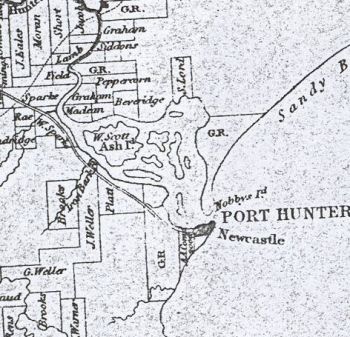William Peppercorn
Eyeball Reach - Map 1
William Peppercorn arrived as a free settler on the ship Surry in 1829. The Surry departed London on 23rd August 1828 and sailed via the Cape arriving in Port Jackson on 22nd January 1829. Other free settlers on this ship included Henry Peppercorn and Mr. James Sea and Miss Sea, cousins of William Peppercorn. The Surry was 347 tons and carried a crew of 18 men.
Land Grant
William Peppercorn was promised one thousand nine hundred and twenty acres on 14th January 1829 by Sir Ralph Darling with a quit rent of £16 per annum. Possession was given on 29th June 1829.
Crop Failure
As can be seen from the correspondence below William Peppercorn began to plant wheat as did other settlers on the Hunter around this time. Mostly the wheat was destroyed by rust. Another settler planting wheat around this time was George Wyndham at Dalwood.Read an extract from George Wyndham's Diary in which he tells of his attempts to plant various crops in the 1830's.
Correspondence
L'Amende Honorable
To the Editor of The Australian.
Sir,
As you constantly avow yourself an advocate for truth I beg to rectify a false statement respecting myself in your paper of Febr 3, 1830. Your correspondent in his article headed 'The River Hunter,' and subscribed 'An Old Hand', writes thus: -
'Bye the bye, the very hospitable Mr. Peppercorn has a most remarkable crop of wheat'. This is false, inasmuch as it was not at all remarkable, for it was almost invisible in a week after it came up, being eaten off every day by sheep and cattle. Secondly - He says - The wheats are transplanted out in wide ditches, like celery on a new plains. Profoundly false; as I never transplanted wheats (a miserable expression) in my life - I never made ditches for wheat - and I never made wheat look like celery on a new plain. - quere - Can your correspondent tell me what a new plain is? I believe all the plains in this Colony are upwards of a thousand years old. The wheats are very easily reaped - one active man will cut down seventy to thirty acres in a day. Execrably false; for it was totally impossible for ten thousand active men to cut down one ear of the said wheats. Bye the bye I did sow wheat in drills which could not have come up better than it did.
With respect to 'the very hospitable,' I must own I am not fond of sitting over the steam of the tea pot (although tea is so cheap), talking scandal, and endeavouring to foment discord in a colony; but if your correspondent is in want of a week's rations, he can have the same by calling on me,
Your obedient servant.
W.H. Peppercorn.
Eyeball Reach, Hunter's River,
26 February 1830.
Assigned Convict Servants
The following convicts were assigned to William Peppercorn at his Hunter River Estate:Dixon Belsey per John assigned servant in September 1829
Thomas Arnold per John assigned servant in September 1829
William Aspeel per Guildford assigned in November 1829
Thomas Boyd per Guildford assigned on November 1829
Patrick Mulowney per City of Edinburgh assigned servant 1832
Patrick Hegarty per City of Edinburgh assigned servant in 1832
James Ball per Andromeda assigned servant in 1833
James Berry per Andromeda assigned servant in 1833
William Peppercorn died at his residence Dowling Street Wooloomooloo on 31 December 1880 aged 77.
Notes and Links
1). An account of a trip by steamer from Newcastle to the Williams River was published in the Newcastle Morning Herald in 1878 in which the Kennington Estate, then owned by William Bowden was mentioned...... On the other side of the water again is Ash Island, on which the principal feature is she well kept farm of Mr. W. Milham. Passing quickly along on the left bank of the river still, are the coal shoots of the Messrs Brown, and the Duckenfield steamer was loading coal underneath them. Hexham township is soon visible from here, and also the old Hexham Hotel, and residence of Mr. John Hannell; whilst on the opposite bank is the Kennington estate, the property of Mr. William Bowden, who owns some 2000 acres of fine agricultural and grazing land. Nearly facing this estate, is what used to be a stirring spot. We can remember it some twenty years ago as a flourishing boiling down establishment, from which hundreds of tons of tallow were sent regularly to market. Adjoining it is the old Alnwick estate, better known as Cock-a-dingy, and fronting it the famous Kinross estate, on which is situated Kinross House, the residence of John Windeyer, Esq, J.P., and a magnificent vineyard surrounds it. This estate adjoins Raymond Terrace, the chief town en route. It is a quiet, pretty, unassuming little spot, and although bristling with houses, hotels, churches, a stranger would never be impressed with the amount of business done. On the left bank is Miller's Forest, which is chiefly devoted to farming purposes.- Newcastle Morning Herald 9 February 1878.↑
